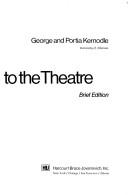| Listing 1 - 10 of 307 | << page >> |
Sort by
|
Book
ISBN: 0714823228 9780714823225 Year: 1985 Publisher: Oxford Phaidon
Abstract | Keywords | Export | Availability | Bookmark
 Loading...
Loading...Choose an application
- Reference Manager
- EndNote
- RefWorks (Direct export to RefWorks)
History --- Theatrical science --- Theater --- History. --- Theater - History

ISBN: 0155469223 9780155469228 Year: 1971 Publisher: San Diego, CA ; London : Harcourt Brace Jovanovich,
Abstract | Keywords | Export | Availability | Bookmark
 Loading...
Loading...Choose an application
- Reference Manager
- EndNote
- RefWorks (Direct export to RefWorks)
Book
ISBN: 0810141752 Year: 2020 Publisher: [s.l.] : Northwestern University Press,
Abstract | Keywords | Export | Availability | Bookmark
 Loading...
Loading...Choose an application
- Reference Manager
- EndNote
- RefWorks (Direct export to RefWorks)
Theaters of Citizenship investigates the Egyptian movement for free theater, arguing that it evolved from an avant-gardist movement to an undercommons of revolutionary cultural practice. Using historiography, ethnography, and performance analysis, the book tells a story of this avant-garde from 2004-2014, analyzing its staging of rights claims, generational identity politics, and post-revolution citizenship. Using Moten and Harney's theory of the undercommons, a space-time for politicized cultural practice, the book extends avant-gardist theater theory to consider the revolutionary potential of performance within and outside theater spaces. Pahwa considers the performer's bodily repertoire as a medium of cultural and political citizenship, drawing on Diana Taylor's concept of repertoire, and expanding it to account for how performance mediates futurist culture and revolutionary practice.
Book
ISBN: 9782355391699 2355391696 Year: 2013 Publisher: Lavérune Entretemps
Abstract | Keywords | Export | Availability | Bookmark
 Loading...
Loading...Choose an application
- Reference Manager
- EndNote
- RefWorks (Direct export to RefWorks)
Voulant donner à voir, sur la scène, "cette vie mystérieuse, joyeuse et superbement aboutie que l'on appelle la Mort", Edward Gordon Craig propose en 1907 de remplacer le comédien de chair et de sang par son double artificiel, la Surmarionnette. Près de soixante-dix ans plus tard, le mannequin en compagnie duquel Tadeusz Kantor fait entrer l'acteur vivant sur la scène vient nous rappeler que le théâtre prend sa source dans les territoires de la mort. Nombreux sont, aujourd'hui, les artistes qui se ressaisissent de ce double héritage, repoussant les limites du théâtre d'acteurs et du théâtre de marionnettes pour explorer les relations entre corps biologique et corps artificiel, représentation de la mort et représentation du vivant. Ce volume rassemble les actes d'un colloque international organisé par l'Institut International de la Marionnette du 15 au 17 mars 2012, et qui a réuni des spécialistes, des universitaires et des artistes venus du monde entier. A travers la diversité des créateurs évoqués (d'Oskar Schlemmer à Gisèle Vienne, de Maurice Maeterlinck à Bérangère Vantusso, de Romeo Castellucci à Kris Verdonck, de Virgilio Sieni à David Girondin-Moab ou Oriza Hirata), la fascination pour un théâtre d'effigies, où les signes de la vie et de la mort se redistribuent, est ainsi examinée dans ses développements les plus récents, d'un point de vue esthétique, poétique, philosophique ou anthropologique.
Kantor, Tadeusz --- Craig, Edward G. --- Puppets --- Marionnettes --- Puppet theater - History

ISBN: 2868691668 9782868691668 Year: 1987 Publisher: Arles
Abstract | Keywords | Export | Availability | Bookmark
 Loading...
Loading...Choose an application
- Reference Manager
- EndNote
- RefWorks (Direct export to RefWorks)
Au théâtre, la mémoire est paradoxale. D'un côté, en tant qu'art, au moins en occident, il n'a qu'une mémoire partielle, trouée, fragmentaire, et de l'autre, il tient de la chose remémorée qui, aujourd'hui encore plus que d'habitude, cherche à se montrer dans l'actualité d'un corps, d'un spectacle. Malgré cette passion récente, le théâtre depuis toujours s'immerge dans ce qui remonte d'autrefois et l'acteur accomplit en lui-même les épousailles de l'ancien temps avec celui de maintenant. Il sert de support et de médiateur, de pont et de souricière - il est au carrefour des durées, car au théâtre le passé s'incarne, devient présent.
Theatrical science --- Theater --- History --- Theater - History - 20th century.
Book
ISBN: 1552387917 1552387895 Year: 2015 Publisher: Calgary, Alberta : Ottawa, Ontario : University of Calgary Press, Canadian Electronic Library,
Abstract | Keywords | Export | Availability | Bookmark
 Loading...
Loading...Choose an application
- Reference Manager
- EndNote
- RefWorks (Direct export to RefWorks)
As playwright, actor, director, teacher, mentor, theatre administrator, and critic, Sharon Pollock has played an integral role in the shaping of Canada's national theatre tradition, and she continues to produce new works and to contribute to Canadian theatre as passionately as she has done over the past fifty years. Pollock is nationally and internationally respected for her work and support of the theatre community. She has also played a major role in informing Canadians about the "dark side" of their history and current events. This collection, comprised entirely of new and original assessments of her work and contribution to theatre, is both timely and long overdue. Includes a new play titled "Sharon's Tongue" by the Playing with Pollock CollectiveWith contributions by:Kathy K. Y. ChungDonna CoatesCarmen DerksenSherrill GraceMartin MorrowJeton NezirajWes PearceTanya SchaapShelley ScottJerry WassermanJason WeinsCynthia Zimmerman.
Book
ISBN: 9004251146 9789004251144 9789004250093 9004250093 Year: 2013 Publisher: Boston Global Oriental
Abstract | Keywords | Export | Availability | Bookmark
 Loading...
Loading...Choose an application
- Reference Manager
- EndNote
- RefWorks (Direct export to RefWorks)
Samuel L. Leiter's Kabuki at the Crossroads: Years of Crisis, 1952-1965 is the first detailed account of Japan's kabuki theatre in the years immediately following the end of the Occupation. It examines every aspect of this traditional theatre as it struggled to maintain its position in a rapidly changing postwar entertainment environment. It covers acting rivalries, major productions, theatres, international tours, the convention of men playing female roles, name-taking and memorial ceremonies, the company system and managerial strategies. In addition, the volume includes numerous appendixes chronicling the period, including a thorough chronology and 150 summaries of new plays never previously discussed in English.
Kabuki --- PERFORMING ARTS / Theater / History & Criticism --- Theater --- History
Book
ISBN: 3319409964 3319409972 Year: 2016 Publisher: Cham : Springer International Publishing : Imprint: Palgrave Macmillan,
Abstract | Keywords | Export | Availability | Bookmark
 Loading...
Loading...Choose an application
- Reference Manager
- EndNote
- RefWorks (Direct export to RefWorks)
‘Terence Rattigan was among the most successful British playwrights of the modern era – a master of comedy as well as tragedy. He is so incredibly good it should come as no surprise that a significant revival has been underway for some time. In fact, Rattigan has been slowly achieving a permanent place of esteem in the essential repertoire of twentieth century dramatists. And that place will be bolstered by this brilliant comprehensive study of the playwright’s art by John A. Bertolini. His book is a pleasure to read: elegantly written, persistently intelligent, and lucid, and it does exactly what it promises: makes a case for Rattigan.’ - Jay Parini, D.E.Axinn Professor of English, Middlebury College, USA This book asserts the extraordinary quality of mid-twentieth century playwright Terence Rattigan’s dramatic art and its basis in his use of subtext, implication, and understatement. By discussing every play in chronological order, the book also articulates the trajectory of Rattigan’s darkening vision of the human potential for happiness from his earlier comedies through his final plays in which death appears as a longed for peace. New here is the exploration through close analysis of Rattigan’s style of writing dialogue and speeches, and how that style expresses Rattigan’s sense of life. Likewise, the book newly examines how Rattigan draws on sources in Greek and Roman history, literature, and myth, as well as how he invites comparison with the work of other playwrights, especially Bernard Shaw and Shakespeare. It will appeal broadly to college and university students studying dramatic literature, but also and especially to actors and directors, and the play-going, play-reading public.
Culture --- Ethnology --- Theater --- Cultural and Media Studies. --- Theatre History. --- British Culture. --- Study and teaching. --- Europe. --- History. --- Rattigan, Terence. --- Cultural studies --- Theater-History. --- Ethnology-Europe. --- Theater—History. --- Ethnology—Europe.
Book
ISBN: 3319548824 3319548816 Year: 2017 Publisher: Cham : Springer International Publishing : Imprint: Palgrave Macmillan,
Abstract | Keywords | Export | Availability | Bookmark
 Loading...
Loading...Choose an application
- Reference Manager
- EndNote
- RefWorks (Direct export to RefWorks)
This book offers the first broad-based survey of the way artists, audiences and society at large are making use of social media, and how the emergence of social media platforms that allow two-way interaction between these groups has been held up as a ‘game changer’ by many in the theatre industry. The first book to analyse aesthetic, critical, audience development, marketing and assessment uptake of social media in the theatre industry in an integrated fashion, Theatre, Social Media and Meaning Making examines examples from the USA, UK, Europe and Australasia to provide a snapshot of this emerging niche within networked, telematic, immersive and participatory theatre production and reception practices. A vital new resource for the field, this book will appeal to scholars, students, and industry practitioners alike.
Theater and social media. --- Social media and theater --- Social media --- Performing arts. --- Theater-History. --- Performing Arts. --- Theatre History. --- Show business --- Arts --- Performance art --- Theater—History.
Book
ISBN: 3319718428 3319718436 Year: 2018 Publisher: Cham : Springer International Publishing : Imprint: Palgrave Macmillan,
Abstract | Keywords | Export | Availability | Bookmark
 Loading...
Loading...Choose an application
- Reference Manager
- EndNote
- RefWorks (Direct export to RefWorks)
The theo-political idea of covenant—a sacred binding agreement—formalizes relationships and inaugurates politics in the Hebrew Bible, and it was the most significant revolutionary idea to come out of the Protestant Reformation. Central to sixteenth-century theology, covenant became the cornerstone of the seventeenth-century English Commonweath, evidenced by Parliament’s passage of the Protestation Oath in 1641 which was the “first national covenant against popery and arbitrary government,” followed by the Solemn League and Covenant in 1643. Although there are plenty of books on Shakespeare and religion and Shakespeare and the Bible, no recent critics have recognized how Shakespeare’s plays popularized and spread the covenant idea, making it available for the modern project. By seeding the plays with allusions to biblical covenant stories, Shakespeare not only lends ethical weight to secular lives but develops covenant as the core idea in a civil religion or a founding myth of the early-modern political community, writ small (family and friendship) and large (business and state). Playhouse relationships, especially those between actors and audiences, were also understood through the covenant model, which lent ethical shading to the convention of direct address. Revealing covenant as the biblical beating heart of Shakespeare’s drama, this book helps to explain how the plays provide a smooth transition into secular society based on the idea of social contract. .
Shakespeare, William, --- Šekspir, Vil'jam --- Criticism and interpretation. --- Bible --- In literature. --- Literature, Modern. --- Shakespeare, William, 1564-1616. --- Theater-History. --- Shakespeare. --- Theatre History. --- Modern literature --- Arts, Modern --- Theater—History.
| Listing 1 - 10 of 307 | << page >> |
Sort by
|

 Search
Search Feedback
Feedback About UniCat
About UniCat  Help
Help News
News